Similarity Chapter Notes | Mathematics Class 10 ICSE PDF Download
Introduction
Imagine looking at a map of your country or a tiny model of a grand building—both are smaller versions of the real thing, yet they look exactly the same in shape! This fascinating concept is called similarity, a key idea in geometry that helps us understand how shapes can be alike even if their sizes differ. In this chapter, we’ll explore how figures like triangles can be similar, how their sides and angles relate, and how this idea applies to everyday things like maps and models. Get ready to dive into the world of proportional shapes and size transformations, and see how math connects to the real world in exciting ways!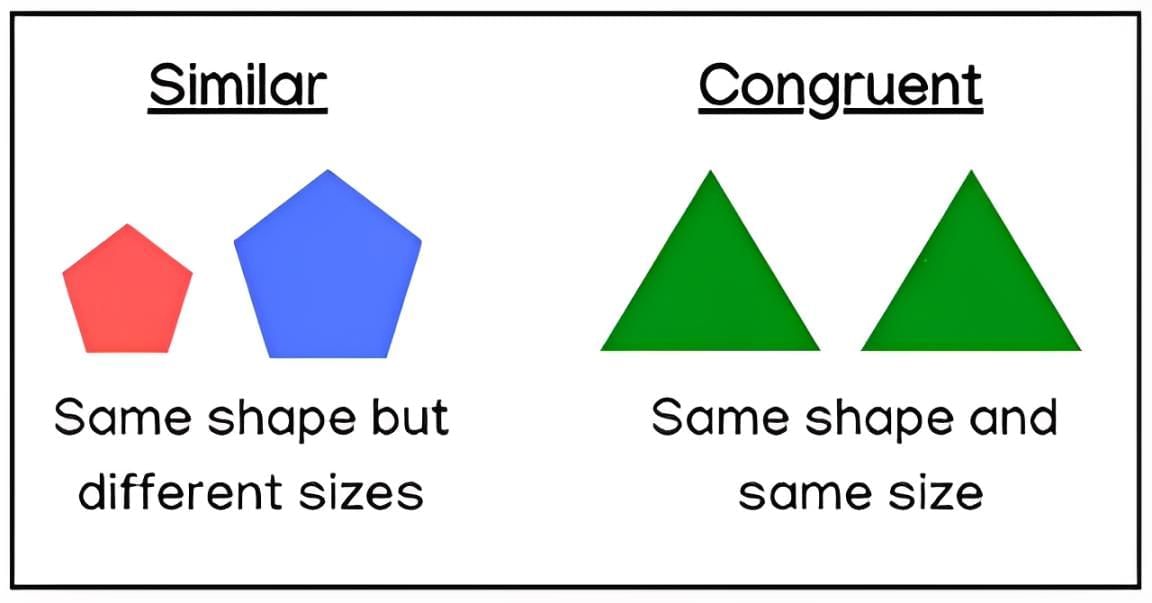
- Similarity in geometry means two figures have the same shape but can be different in size.
- Steps to understand similarity:
- Identify the shape: Check if two figures look alike in their form.
- Compare angles: For figures to be similar, their angles must be equal.
- Check sizes: Sizes may differ, but the shape remains the same.
- Congruency means two figures have both the same shape and the same size.
- Steps to understand congruency:
- Match shapes: Ensure the figures have identical forms.
- Measure sides: All sides of one figure must equal the sides of the other.
- Confirm angles: All angles must be equal too.
- Congruent figures are always similar, but similar figures are not always congruent.
Similar Triangles
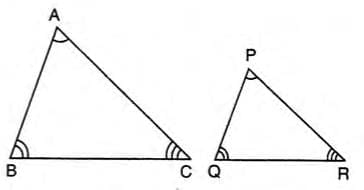
- Two triangles are similar if their corresponding angles are equal and their corresponding sides are proportional.
- Steps to check for similar triangles:
- Measure angles: Ensure each angle in one triangle equals the corresponding angle in the other.
- Compare sides: Calculate the ratios of corresponding sides; they must be equal.
- Conditions for similarity:
- Corresponding angles are equal: Angle A = Angle P, Angle B = Angle Q, Angle C = Angle R.
- Corresponding sides are proportional: AB/PQ = BC/QR = AC/PR.
- Notation: We write ΔABC ~ ΔPQR to show triangle ABC is similar to triangle PQR.
- Example: In triangles ABC and PQR, if Angle A = Angle P, Angle B = Angle Q, Angle C = Angle R, and AB/PQ = BC/QR = AC/PR, then ΔABC ~ ΔPQR.
Corresponding Sides and Corresponding Angles
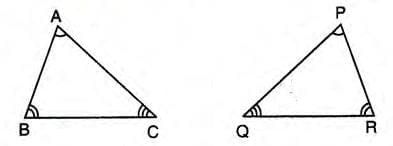
- In similar triangles, sides opposite to equal angles are called corresponding sides.
- Steps to identify corresponding sides:
- Find equal angles: Locate angles that are the same in both triangles.
- Identify opposite sides: The sides opposite these equal angles are corresponding.
- Example: In ΔABC ~ ΔPRQ, if Angle A = Angle P, then sides BC and QR (opposite to Angle A and Angle P) are corresponding sides.
- Formula: For similar triangles ABC and PRQ, BC/QR = AC/PQ = AB/PR.
- In similar triangles, angles opposite to proportional sides are corresponding angles and are equal.
- Steps to identify corresponding angles:
- Check side ratios: Find the ratios of corresponding sides.
- Locate opposite angles: The angles opposite these proportional sides are corresponding and equal.
- Example: In similar triangles ABC and EFD, if AB/EF = BC/DF = AC/DE, then Angle C (opposite AB) = Angle D (opposite EF), Angle A (opposite BC) = Angle E (opposite DF), and Angle B (opposite AC) = Angle F (opposite DE).
Condition of Similar Triangle (SAS, AA or AAA and SSS)
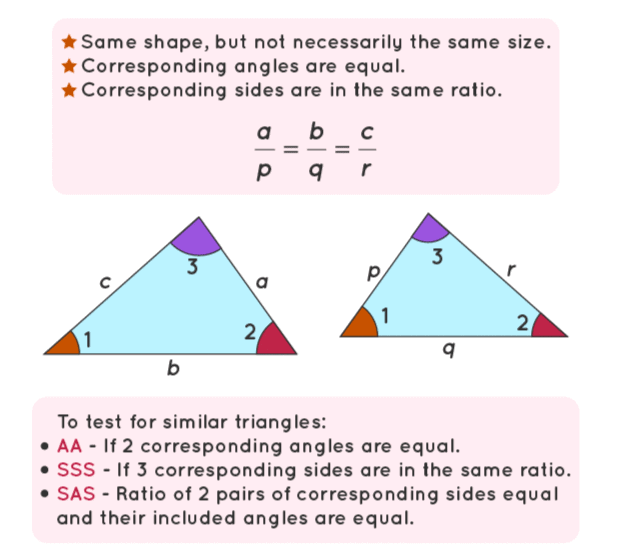
1. SAS (Side-Angle-Side): If one angle of a triangle equals an angle of another, and the sides including these angles are proportional.
- Steps for SAS:
- Compare one angle: Check if one angle is equal in both triangles.
- Measure including sides: Find the lengths of the sides that form this angle.
- Check proportionality: Ensure the ratios of these sides are equal.
- Example: In ΔABC and ΔDEF, if Angle A = Angle D and AB/DE = AC/DF, then ΔABC ~ ΔDEF by SAS.
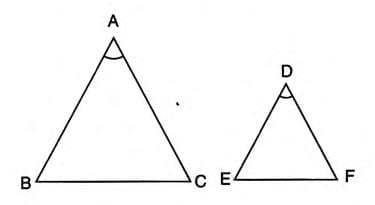
2. AA or AAA (Angle-Angle): If two angles of one triangle equal two angles of another.
- Steps for AA or AAA:
- Measure two angles: Check if two angles in one triangle match two in the other.
- Third angle: Since the sum of angles in a triangle is 180°, the third angles will also be equal.
- Example: In ΔABC and ΔDEF, if Angle A = Angle D and Angle B = Angle E, then ΔABC ~ ΔDEF by AA.
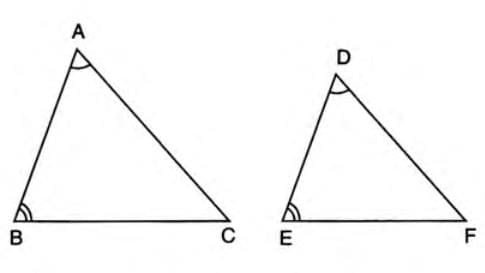
3. SSS (Side-Side-Side): If all three pairs of corresponding sides are proportional.
- Steps for SSS:
- Measure all sides: Find the lengths of all sides in both triangles.
- Calculate ratios: Check if the ratios of corresponding sides are equal.
- Example: In ΔABC and ΔPQR, if AB/PQ = BC/QR = AC/PR, then ΔABC ~ ΔPQR by SSS.
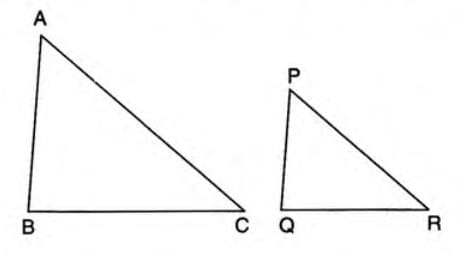
Basic Proportionality Theorem with Applications
Theorem 1: Basic Proportionality Theorem (BPT) or Thales' Theorem
- A line drawn parallel to one side of a triangle divides the other two sides proportionally.
- Given: In ΔABC, line DE is parallel to BC, with D on AB and E on AC.
- To Prove: AD/DB = AE/EC.
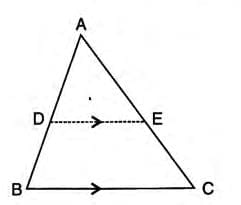
- Proof:
- Statement: In ΔABC and ΔADE:
- ∠ABC = ∠ADE (Corresponding angles, since DE || BC).
- ∠ACB = ∠AED (Corresponding angles).
- ∠BAC = ∠DAE (Common angle).
- Therefore, ΔABC ~ ΔADE (AAA postulate).
- Since the triangles are similar, their corresponding sides are proportional:
- AB/AD = AC/AE (Corresponding sides of similar triangles).
- Now, AB = AD + DB and AC = AE + EC.
- Substitute: (AD + DB)/AD = (AE + EC)/AE.
- Rewrite: (AD/AD) + (DB/AD) = (AE/AE) + (EC/AE).
- Simplify: 1 + (DB/AD) = 1 + (EC/AE).
- Subtract 1: DB/AD = EC/AE.
- Take reciprocals: AD/DB = AE/EC.
- Hence proved.
- Converse: If a line divides any two sides of a triangle proportionally, the line is parallel to the third side.
- Given: In ΔABC, D and E are points on AB and AC such that AD/DB = AE/EC.
- To Prove: DE || BC.
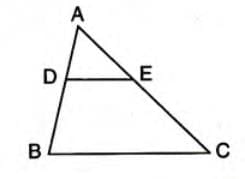
- Proof:
- Assume DE is not parallel to BC.
- Draw DF || BC, where F is a point on AC.
- By BPT in ΔABC with DF || BC: AD/DB = AF/FC.
- Given: AD/DB = AE/EC.
- So, AF/FC = AE/EC.
- Rewrite: AF/FC = AE/EC implies (AF/AE) = (FC/EC).
- Add 1: (AF/AE) + 1 = (FC/EC) + 1.
- So, (AF + AE)/AE = (FC + EC)/EC.
- Since AC = AE + EC, we get: (AF + AE)/AE = AC/EC.
- Similarly, (AF + AE)/AE = AC/AE.
- Thus, AC/EC = AC/AE, which implies EC = AE, a contradiction unless E and F coincide.
- Therefore, DE || BC.
Example: In ΔABC, DE || BC, AD/DB = 2/3, and BC = 7.5 cm. Find DE.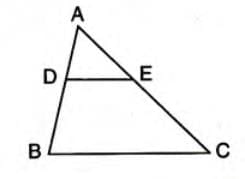 Solution:
Solution:
- By BPT: AD/DB = AE/EC.
- Also, since ΔADE ~ ΔABC (by AA), AD/AB = DE/BC.
- Given: AD/DB = 2/3, so AD/DB = 2/3 implies AD/(AD + DB) = 2/(2 + 3) = 2/5.
- Since AB = AD + DB, we have AD/AB = 2/5.
- Thus, DE/BC = AD/AB = 2/5.
- So, DE/7.5 = 2/5.
- DE = (2/5) × 7.5 = 3 cm.
Relation Between the Areas of Two Triangles
Theorem 2: Area Ratio Theorem for Similar Triangles
- The corresponding sides of similar triangles are proportional to the squares of their areas.
- Given: ΔABC ~ ΔDEF, such that ∠B = ∠E and ∠C = ∠F.
- To Prove: (Area of ΔABC)/(Area of ΔDEF) = (AB/DE)² = (BC/EF)² = (AC/DF)².
- Construction: Draw AM ⊥ BC and DN ⊥ EF.

- Proof:
- Area of ΔABC = (1/2) × BC × AM.
- Area of ΔDEF = (1/2) × EF × DN.
- So, (Area of ΔABC)/(Area of ΔDEF) = [(1/2) × BC × AM]/[(1/2) × EF × DN] = (BC/EF) × (AM/DN).
- In ΔABM and ΔDEN:
- ∠AMB = ∠DNE (Each 90°, since AM ⊥ BC and DN ⊥ EF).
- ∠B = ∠E (Given, since ΔABC ~ ΔDEF).
- Thus, ΔABM ~ ΔDEN (AA postulate).
- So, AM/DN = AB/DE (Corresponding sides of similar triangles).
- Substitute: (Area of ΔABC)/(Area of ΔDEF) = (BC/EF) × (AM/DN) = (BC/EF) × (AB/DE).
- Since ΔABC ~ ΔDEF, AB/DE = BC/EF = AC/DF.
- Thus, (Area of ΔABC)/(Area of ΔDEF) = (BC/EF) × (AB/DE) = (AB/DE) × (AB/DE) = (AB/DE)².
- Similarly, it equals (BC/EF)² and (AC/DF)².
- Hence proved.
- Remark: If two triangles share a common vertex and their bases are along the same straight line, the ratio of their areas equals the ratio of their bases.
Example: In ΔABC, D and E are points on AB and AC such that DE || BC. Find the ratio of areas of ΔADE to ΔABC.
Solution: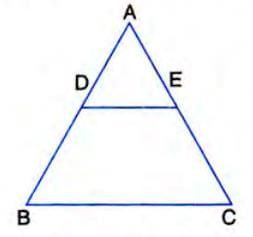
- Since DE || BC, by BPT: AD/DB = AE/EC.
- Also, ΔADE ~ ΔABC (by AA, since ∠A is common and ∠ADE = ∠ABC).
- By the area ratio theorem: (Area of ΔADE)/(Area of ΔABC) = (AD/AB)².
- Since AB = AD + DB, we need AD/AB, which depends on the specific ratio AD/DB (can be computed if given).
Similarity as a Size Transformation
- Similarity can be seen as a size transformation, where a figure is enlarged or reduced by a scale factor k.
- Steps for size transformation:
- Choose a point: Select a center of enlargement or reduction (e.g., point P).
- Scale the distances: Multiply the distance from P to each vertex by the scale factor k.
- Join new points: Connect the new points to form the transformed figure.
- Enlargement: If k > 1, the figure gets bigger.
- Example: For triangle ABC, mark point P outside. Join P to A, B, C.
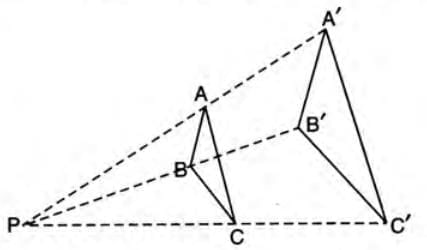 Produce PA to A' such that PA' = 2 × PA, PB to B' such that PB' = 2 × PB, and PC to C' such that PC' = 2 × PC. Join A', B', C' to get ΔA'B'C' ~ ΔABC, with A'B' = 2 × AB, B'C' = 2 × BC, C'A' = 2 × CA (scale factor k = 2).
Produce PA to A' such that PA' = 2 × PA, PB to B' such that PB' = 2 × PB, and PC to C' such that PC' = 2 × PC. Join A', B', C' to get ΔA'B'C' ~ ΔABC, with A'B' = 2 × AB, B'C' = 2 × BC, C'A' = 2 × CA (scale factor k = 2). - Reduction: If k < 1, the figure gets smaller.
- Example: For triangle ABC and point P, take A' in PA such that PA' = 1/2 × PA, B' in PB such that PB' = 1/2 × PB, and C' in PC such that PC' = 1/2 × PC.
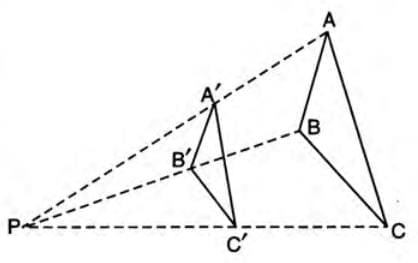 Join A', B', C' to get ΔA'B'C' ~ ΔABC, with A'B' = 1/2 × AB, B'C' = 1/2 × BC, C'A' = 1/2 × CA (scale factor k = 1/2).
Join A', B', C' to get ΔA'B'C' ~ ΔABC, with A'B' = 1/2 × AB, B'C' = 1/2 × BC, C'A' = 1/2 × CA (scale factor k = 1/2). - Properties of size transformation:
- The image of a line is a line.
- The image of a triangle is a triangle.
- The image of a quadrilateral is a quadrilateral, and so on.
Applications to Maps and Models
- Similarity is used in maps and models to represent real objects at a smaller or larger scale.
- Steps to understand maps:
- Measure distances: Find the distance between two points on the map.
- Compare to actual: Compare this to the real distance between the points.
- Find the scale: The ratio of map distance to actual distance is the scale factor k.
- Example: On a map of India, if the scale is 1:20,000, then 1 cm on the map equals 20,000 cm (0.2 km) on the ground.
- Scale factor (k): The ratio written on maps, e.g., 1:20,000, means k = 1/20,000.
- Steps for models:
- Understand the object: Know the dimensions of the real object.
- Apply scale factor: Use k to find the model’s dimensions (multiply real dimensions by k for reduction, or divide model dimensions by k for actual size).
- Calculate properties: Use k for lengths, k2 for areas, and k3 for volumes.
- Formulas for maps and models:
- Length of model = k × length of actual object.
- Area of model = k2 × area of actual object.
- Volume of model = k3 × volume of actual object.
Solved Examples
Example 1: Right-Angled Triangle and Altitude
Problem: In triangle ABC, right-angled at A, AD is perpendicular to BC. Prove ΔDBA ~ ΔDAC ~ ΔABC.
Solution: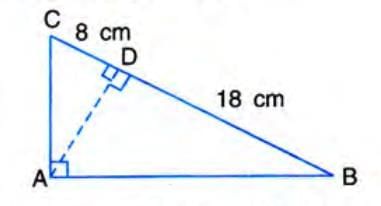
- In ΔDBA and ΔABC:
- Angle ABD = Angle ABC (common).
- Angle ADB = Angle BAC (each 90°).
- Thus, ΔDBA ~ ΔABC by AA postulate.
- In ΔDAC and ΔABC:
- Angle ACD = Angle ACB (common).
- Angle ADC = Angle BAC (each 90°).
- Thus, ΔDAC ~ ΔABC by AA postulate.
- Conclusion: ΔDBA ~ ΔDAC ~ ΔABC.
Example 2: Parallel Lines and Transversals
Problem: Lines l and m are parallel. Three concurrent lines through point O meet l at A, B, C and m at P, Q, R. Prove AB/BC = QR/PQ.
Solution:
Since l || m and AR is a transversal:
- Angle OAB = Angle ORQ (alternate angles).
- Angle AOB = Angle QOR (vertically opposite angles).
- Thus, ΔOAB ~ ΔORQ by AA postulate.
- So, AB/QR = OB/OQ (corresponding sides are proportional).
- Angle OCB = Angle OPQ (alternate angles).
- Angle BOC = Angle POQ (vertically opposite angles).
- Thus, ΔBOC ~ ΔQOP by AA postulate.
- So, BC/PQ = OB/OQ (corresponding sides are proportional).
From both, AB/QR = BC/PQ, hence AB/BC = QR/PQ.
Example 3: Model of a Tank
Problem: A rectangular tank has length = 4 m, width = 3 m, capacity = 30 m3. A model has capacity 240 cm3. Find (i) dimensions of the model, (ii) ratio of total surface area of tank to model.
Solution:
Step 1: Find height of tank.
- Volume = length × breadth × height.
- 30 m3 = 4 m × 3 m × height.
- Height = 30 / (4 × 3) = 2.5 m.
- Volume of model = k3 × volume of tank.
- 240 cm3 = k3 × 30 m3.
- Convert units: 30 m3 = 30 × 100 × 100 × 100 cm3.
- So, 240 = k3 × 30 × 100 × 100 × 100.
- k3 = 240 / (30 × 100 × 100 × 100) = 1/125000.
- Scale factor k = 1/50.
- (i) Dimensions of the model:
- Length of model = k × length of tank = 1/50 × 4 m = 8 cm.
- Breadth of model = k × breadth of tank = 1/50 × 3 m = 6 cm.
- Height of model = k × height of tank = 1/50 × 2.5 m = 5 cm.
- Dimensions = 8 cm × 6 cm × 5 cm.
- (ii) Ratio of total surface areas:
- Total surface area of model = k2 × total surface area of tank.
- So, total S.A. of tank / total S.A. of model = 1/k2.
- = 1/(1/50)2 = 502 = 2500.
- Ratio = 2500:1.
|
74 videos|198 docs|30 tests
|
FAQs on Similarity Chapter Notes - Mathematics Class 10 ICSE
| 1. What are similar triangles and how can they be identified? |  |
| 2. What is the Basic Proportionality Theorem and how can it be applied? |  |
| 3. How does similarity relate to the areas of two triangles? |  |
| 4. Can you explain the concept of similarity as a size transformation? |  |
| 5. How are similar triangles used in real-world applications, such as maps and models? |  |
















